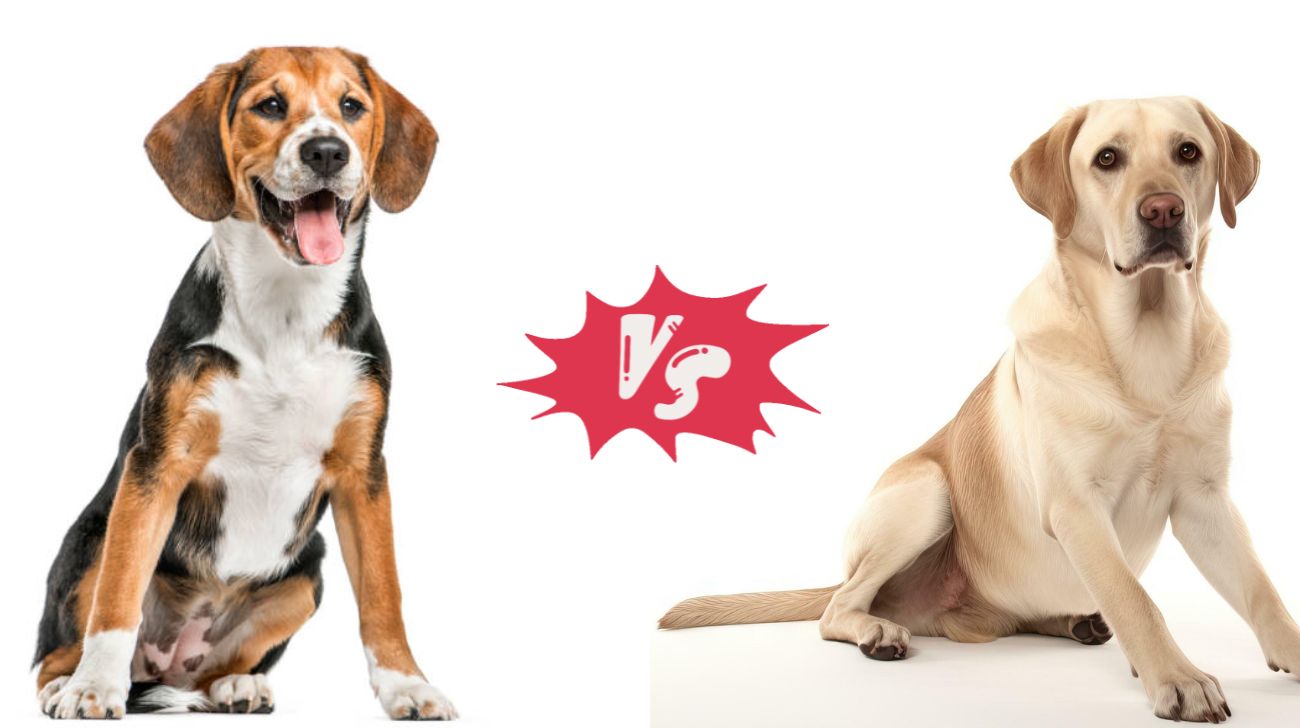Choosing the right dog breed is a crucial decision that can significantly impact your lifestyle and home environment. Among the many popular breeds, Beagles and Labradors consistently rank high in popularity worldwide. Both breeds are cherished for their unique characteristics, making them favourites among families, individuals, and dog lovers alike. However, a key question arises in the debate of Beagle vs Labrador – Is a Beagle a better choice than a Labrador?
This comprehensive comparison examines various aspects of both breeds to help you determine which one might be the better fit for your life and preferences.
Quick Answer – Is a Beagle Better Than a Labrador?
Is a Beagle better than a Labrador? Whether a Beagle is better than a Labrador depends on your lifestyle and preferences. Beagles are smaller, independent, and suited for moderate exercise, while Labradors are larger, highly trainable, and need more physical activity. Both are excellent family dogs, but the best choice depends on your specific needs.

Beagles vs Labradors – Breed Origins
Beagles and Labradors are two of the most popular dog breeds globally, each with its unique set of traits that appeal to different types of dog owners. Understanding the similarities and differences between these breeds is crucial in determining which one aligns better with your lifestyle, preferences, and expectations.
Beagles
Beagles are one of the oldest dog breeds, with origins tracing back to ancient Greece and Rome. However, the modern Beagle as we know it today was primarily developed in England. Historically, Beagles were bred for hunting due to their exceptional sense of smell and tracking abilities. Their size and stamina made them ideal for flushing out game from dense underbrush. Read the full AKC Beagle breed profile for detailed temperament and care insights.

Labradors
Labradors, on the other hand, hail from Newfoundland, Canada. Initially known as “St. John’s Dogs,” Labrador Retrievers were bred to assist fishermen in retrieving nets and catching escaping fish.
The breed was refined in the United Kingdom, where the Labrador Retriever was standardised. Today, Labradors are renowned for their versatility, serving as guide dogs, search and rescue dogs and beloved family pets. Discover if it’s advisable to leave a dog’s collar on at all times and how to ensure your pet’s comfort. Learn about Labrador Retriever traits and health from VCA’s expert veterinary team.

Comparison Table: Beagle Vs Labrador
1. Physical Characteristics
Beagles
- Size: Beagles are small to medium-sized dogs, typically weighing between 20 to 25 pounds.
- Height: They stand about 13 to 15 inches tall at the shoulder.
- Build: Beagles have a sturdy, compact build with a short, smooth coat.
- Colour: Common colours include tricolour (black, white, and tan), red and white, and lemon.
Labradors
- Size: Labrador Retrievers are larger, typically weighing between 55 and 80 pounds.
- Height: Males stand about 22.5 to 24.5 inches tall, while females are slightly smaller.
- Build: Labradors have a strong, athletic build with a dense, water-resistant double coat.
- Colour: Labradors come in three primary colours: black, yellow, and chocolate.
2. Temperament and Personality

Beagles
Beagles are renowned for their friendly and inquisitive nature, making them exceptional companions for families. Their short, dense coat requires regular maintenance to keep shedding under control and their fur looking healthy. Choosing the ideal brush for Beagle fur care ensures that grooming sessions are practical and comfortable for your pup.
Labradors
Labradors are celebrated for their gentle and outgoing temperament. They are highly intelligent, loyal, and eager to please, making them excellent companions and working dogs. Labradors are typically very patient and tolerant, which makes them excellent companions for children and other animals. Their strong desire for human interaction means they thrive on attention and affection.
3. Intelligence and Trainability
Beagles
Beagles possess a moderate level of intelligence. They are capable of learning a variety of commands and tricks, but their strong scent drive can sometimes lead to distractions during training sessions. Consistent, positive reinforcement methods are most effective with Beagles. They can be stubborn at times, requiring patience and creativity from their owners.
Labradors
Labradors are highly intelligent and are considered one of the smartest dog breeds. Their quick learning ability and strong work ethic make them highly trainable. Labradors excel in obedience training and are often employed in roles that require advanced training, such as service dogs and search and rescue operations. Their eagerness to please facilitates practical training.
4. Energy Levels and Exercise Needs
Beagles
Beagles have high energy levels and require regular exercise to maintain their health and happiness. They enjoy activities like walking, running, and playing games that stimulate their senses, such as tracking and scent games. Without adequate exercise, Beagles can become bored and may develop destructive behaviours. Find out whether collars are bad for a dog’s neck and fur and how to avoid common issues.
Labradors
Labradors also have high energy levels and demand substantial physical and mental stimulation. They thrive on activities like fetching, swimming, agility training, and hiking. Labradors are well-suited for active families and individuals who enjoy an active lifestyle. Regular exercise is essential for preventing obesity and maintaining a healthy physique.
5. Health and Lifespan
Beagles
Beagles are generally healthy dogs with a lifespan of about 12 to 15 years. However, they are prone to certain health issues, including:
- Hip Dysplasia: A genetic condition affecting the hip joints.
- Epilepsy: Seizure disorders that can vary in severity.
- Hypothyroidism: A condition where the thyroid gland does not produce enough hormones.
- Intervertebral Disc Disease (IVDD): A spinal condition that can cause pain and mobility issues.
Regular veterinary check-ups and a healthy diet can help manage and prevent many of these conditions.
Labradors
Labradors have a slightly shorter lifespan, typically around 10 to 12 years. Common health concerns in Labradors include:
- Hip and Elbow Dysplasia: Genetic conditions affecting joint health.
- Osteochondritis Dissecans (OCD): A joint disorder that can cause pain and arthritis.
- Progressive Retinal Atrophy (PRA): A group of genetic diseases leading to blindness.
- Obesity: Labradors are prone to weight gain, which can exacerbate other health issues.
Maintaining a balanced diet and regular exercise regimen is essential to mitigate these health risks.
6. Grooming and Maintenance
Beagles
Beagles have a short, dense coat that requires minimal grooming. Weekly brushing helps remove loose hairs and keeps the coat shiny. If you’re wondering which brush works best for a Beagle’s coat, check out our guide on what you should brush your Beagle with. Regular ear cleaning is necessary to prevent infections, as Beagles’ floppy ears can trap moisture and debris, making them susceptible to infections. Additionally, regular nail trimming and dental care are essential for maintaining overall health.
Labradors
Labradors have a double coat that sheds seasonally, requiring more frequent grooming compared to Beagles. Weekly brushing helps manage shedding and maintain coat health. If you’re curious about how Labradors compare to another popular breed, check out our guide on the differences between Golden Retrievers and Labradors in our detailed comparison of the Golden Retriever vs. Labrador. During shedding seasons, daily brushing may be necessary to prevent matting and tangles. Labradors also need regular ear cleaning, nail trimming, and dental care to prevent common health issues.
7. Suitability for Families and Living Situations

Beagles
Beagles are excellent family dogs due to their friendly and playful nature. They get along well with children and other pets, making them a harmonious addition to households with multiple pets. Beagles are adaptable to various living situations, including apartments, provided they receive adequate exercise and mental stimulation.
Labradors
Labradors are excellent family pets, recognised for their patience and gentle nature around children. Their size and strength make them better suited for homes with larger yards where they can run and play. Although Labradors can adapt to living in apartments, they need plenty of exercise and mental stimulation to avoid boredom and destructive behaviours.
8. Diet and Nutrition
Beagles
Beagles have a hearty appetite and are known to be food-motivated, which can lead to overeating if not properly managed. A balanced diet tailored to their age, size, and activity level is essential. Portion control and regular feeding schedules help prevent obesity, a common issue in Beagles.
Labradors
Labradors are also prone to overeating and obesity due to their love for food. They require a diet that supports their high energy levels and muscular build. Monitoring their calorie intake and providing regular exercise are crucial to maintaining a healthy weight. High-quality dog food formulated for active breeds is recommended.
9. Common Behavioural Issues
Beagles
Beagles are generally well-behaved but can exhibit certain behavioural challenges:
- Stubbornness: Beagles may resist commands if not properly motivated.
- Scent-Driven Behaviour: Their strong sense of smell can lead to wandering and chasing scents.
- Vocalisation: Beagles are known to be vocal and may bark or howl more frequently.
Consistent training and mental stimulation can help mitigate these issues.
Labradors
Labradors are typically well-mannered but can face specific behavioural concerns:
- Excessive Energy: Without adequate exercise, Labradors can become hyperactive and destructive.
- Chewing: Labradors may chew on furniture or other household items if bored.
- Shedding: Their heavy shedding can be a nuisance for some owners.
Proper training, regular exercise, and mental enrichment are key to addressing these behaviours.
10. Cost of Ownership
| Expense Type | Beagle | Labrador |
|---|---|---|
| Food (monthly avg) | £20–£30 | £40–£60 |
| Grooming | Low | Medium |
| Health care | Moderate | Higher (due to size) |
| Insurance (UK avg) | £30-50/month | £40–£60/month |
Beagles
Beagles are relatively affordable to own. Initial costs include purchasing or adopting the dog, basic supplies (such as collars, leashes, and bedding), and initial veterinary visits (including vaccinations and spaying or neutering). Ongoing costs involve food, routine veterinary care, grooming supplies, and training classes. Beagles’ smaller size generally means lower food and supply costs compared to larger breeds.
Labradors
Labradors can be more expensive to own because of their larger size and higher maintenance needs. While the initial costs may be similar to those of Beagles, expenses can increase due to the need for larger supplies. Ongoing expenses include larger amounts of food, higher veterinary costs because of potential health issues, and increased grooming costs. Additionally, Labradors may require more investment in obedience classes or specialised training due to their training needs.
Final Verdict: Beagle or Labrador?
Deciding whether a Beagle is better than a Labrador ultimately depends on your lifestyle, preferences, and what you seek in a canine companion. Here’s a quick summary to help you make an informed decision:
- Beagles are ideal for those seeking a smaller to medium-sized dog with a friendly, curious nature. They are well-suited for families with children and other pets, as well as individuals living in various housing situations, including apartments. Beagles require regular exercise and mental stimulation but are generally easier to manage in terms of grooming and maintenance.
- Labradors are ideal for active individuals or families who enjoy outdoor activities and are committed to providing ample exercise and mental stimulation. Their larger size and higher energy levels make them better suited for homes with spacious yards. Labradors are highly trainable and excel in roles that require intelligence and obedience, such as service dogs or search and rescue teams.
| Choose a Beagle if… | Choose a Labrador if… |
|---|---|
| You want a smaller, lower-maintenance dog | You want an active, trainable companion |
| You live in a flat or smaller space | You have a garden or large home |
| You prefer moderate daily activity | You have a garden or a large home |
Both Beagles and Labradors are outstanding dog breeds, each with unique strengths and characteristics. When deciding between the two, consider your living situation, activity level, and what you desire in terms of temperament and maintenance needs. This will help you choose the breed that best fits your lifestyle. Regardless of whether you pick a Beagle or a Labrador, both breeds are known for their unwavering loyalty, companionship, and the joy they bring as cherished family members. Additionally, if you have dogs with thick skin, it’s essential to learn the best practices for fitting a collar to ensure it’s comfortable and does not cause irritation.

